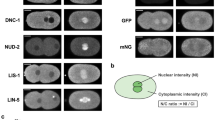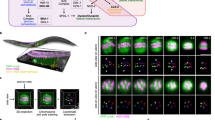Abstract
The movement of chromosomes during mitosis occurs on a bipolar, microtubule-based protein machine, the mitotic spindle. It has long been proposed that poleward chromosome movements that occur during prometaphase and anaphase A are driven by the microtubule motor cytoplasmic dynein, which binds to kinetochores and transports them toward the minus ends of spindle microtubules. Here we evaluate this hypothesis using time-lapse confocal microscopy to visualize, in real time, kinetochore and chromatid movements in living Drosophila embryos in the presence and absence of specific inhibitors of cytoplasmic dynein. Our results show that dynein inhibitors disrupt the alignment of kinetochores on the metaphase spindle equator and also interfere with kinetochore- and chromatid-to-pole movements during anaphase A. Thus, dynein is essential for poleward chromosome motility throughout mitosis in Drosophila embryos.
This is a preview of subscription content, access via your institution
Access options
Subscribe to this journal
Receive 12 print issues and online access
$209.00 per year
only $17.42 per issue
Buy this article
- Purchase on Springer Link
- Instant access to full article PDF
Prices may be subject to local taxes which are calculated during checkout







Similar content being viewed by others
References
Paschal, B. M. & Vallee, R. B. Retrograde transport by the microtubule-associated protein MAP 1C. Nature 330, 181–183 (1987).
Karki, S. & Holzbaur, E. L. Cytoplasmic dynein and dynactin in cell division and intracellular transport. Curr. Opin. Cell Biol. 11, 45–53 (1999).
Sharp, D. J. et al. Functional coordination of three mitotic motors in drosophila embryos. Mol. Biol. Cell 11, 241– 253 (2000).
Saunders, W. S., Koshland, D., Eshel, D., Gibbons, I. R. & Hoyt, M. A. Saccharomyces cerevisiae kinesin- and dynein-related proteins required for anaphase chromosome segregation. J. Cell Biol. 128, 617– 624 (1995).
Pfarr, C. M. et al. Cytoplasmic dynein is localized to kinetochores during mitosis . Nature 345, 263–265 (1990).
Steuer, E. R., Wordeman, L., Schroer, T. A. & Sheetz, M. P. Localization of cytoplasmic dynein to mitotic spindles and kinetochores. Nature 345, 266–268 ( 1990).
Wordeman, L., Steuer, E. R., Sheetz, M. P. & Mitchison, T. Chemical subdomains within the kinetochore domain of isolated CHO mitotic chromosomes. J. Cell Biol. 114, 285– 294 (1991).
Echeverri, C. J., Paschal, B. M., Vaughan, K. T. & Vallee, R. B. Molecular characterization of the 50-kD subunit of dynactin reveals function for the complex in chromosome alignment and spindle organization during mitosis. J. Cell Biol. 132, 617– 633 (1996).
Starr, D. A., Williams, B. C., Hays, T. S. & Goldberg, M. L. Zw10 helps recruit dynactin and dynein to the kinetochore. J. Cell Biol. 142, 763–774 ( 1998).
Karki, S., LaMonte, B. & Holzbaur, E. L. Characterization of the p22 subunit of dynactin reveals the localization of cytoplasmic dynein and dynactin to the midbody of dividing cells. J. Cell Biol. 142, 1023– 1034 (1998) [published erratum J. Cell Biol. 143, 560; 1998].
McNeill, P. A. & Berns, M. W. Chromosome behavior after laser microirradiation of a single kinetochore in mitotic PtK2 cells . J. Cell Biol. 88, 543– 553 (1981).
Rieder, C. L. & Salmon, E. D. Motile kinetochores and polar ejection forces dictate chromosome position on the vertebrate mitotic spindle. J. Cell Biol. 124, 223– 233 (1994).
Bowman, A. B. et al. Drosophila roadblock and Chlamydomonas LC7: a conserved family of dynein-associated proteins involved in axonal transport, flagellar motility, and mitosis. J. Cell Biol. 146, 165–180 (1999).
Karess, R. E. & Glover, D.M. rough deal: a gene required for proper mitotic segregation in Drosophila. J. Cell Biol. 109, 2951–2961 (1989).
Williams, B. C., Karr, T. L., Montgomery, J. M. & Goldberg, M. L. The Drosophila l(1)zw10 gene product, required for accurate mitotic chromosome segregation, is redistributed at anaphase onset. J. Cell Biol. 118, 759– 773 (1992).
Williams, B. C., Gatti, M. & Goldberg, M. L. Bipolar spindle attachments affect redistributions of Zw10, a Drosophila centromere/kinetochore component required for accurate chromosome segregation. J. Cell Biol. 134, 1127–1140 (1996).
Yucel, J. K. et al. CENP-meta, an essential kinetochore kinesin required for the maintenance of metaphase chromosome alignment in Drosophila. J. Cell Biol. 150, 1–12 (2000).
Moore, D. P., Page, A. W., Tang, T. T., Kerrebrock, A. W. & Orr-Weaver, T. L. The cohesion protein MEI-S332 localizes to condensed meiotic and mitotic centromeres until sister chromatids separate. J. Cell Biol. 140, 1003–1012 (1998).
Sullivan, W. & Theurkauf, W. E. The cytoskeleton and morphogenesis of the early Drosophila embryo. Curr. Opin. Cell Biol. 7, 18–22 (1995).
Heald, R. et al. Self-organization of microtubules into bipolar spindles around artificial chromosomes in Xenopus egg extracts. Nature 382, 420–425 (1996).
Robinson, J. T., Wojcik, E. J., Sanders, M. A., McGrail, M. & Hays, T. S. Cytoplasmic dynein is required for the nuclear attachment and migration of centrosomes during mitosis in Drosophila. J. Cell Biol. 146, 597–608 (1999).
Waters, J. C., Mitchison, T. J., Rieder, C. L. & Salmon, E. D. The kinetochore microtubule minus-end disassembly associated with poleward flux produces a force that can do work. Mol. Biol. Cell 7, 1547–1558 ( 1996).
Straight, A. F., Marshall, W. F., Sedat, J. W. & Murray, A. W. Mitosis in living budding yeast: anaphase A but no metaphase plate. Science 277, 574– 578 (1997).
Gorbsky, G. J., Chen, R. H. & Murray, A. W. Microinjection of antibody to Mad2 protein into mammalian cells in mitosis induces premature anaphase. J. Cell Biol. 141, 1193–1205 (1998).
Vaisberg, E. A., Koonce, M. P. & McIntosh, J. R. Cytoplasmic dynein plays a role in mammalian mitotic spindle formation. J. Cell Biol. 123, 849–858 (1993).
Savoian, M. S., Goldberg, M. L. & Rieder, C. L. The rate of poleward chromosome motion is attenuated in Drosophila zw10 and rod mutants. Nature Cell Biol. 2, 948–952 (2000).
Orozco, J. T. et al. Movement of motor and cargo along cilia. Nature 398, 674 (1999).
Signor, D. et al. Role of a class DHC1b dynein in retrograde transport of IFT motors and IFT raft particles along cilia, but not dendrites, in chemosensory neurons of living Caenorhabditis elegans. J. Cell Biol. 147, 519–530 ( 1999).
Skibbens, R. V., Skeen, V. P. & Salmon, E. D. Directional instability of kinetochore motility during chromosome congression and segregation in mitotic newt lung cells: a push-pull mechanism. J. Cell Biol. 122, 859–875 (1993).
Vernos, I. & Karsenti, E. in Dynamics of Cell Division (ed. Glover, S. A. E. a. D. M.) 97–123 (Oxford Univ. Press, 1998).
Yen, T. J., Li, G., Schaar, B. T., Szilak, I. & Cleveland, D. W. CENP-E is a putative kinetochore motor that accumulates just before mitosis. Nature 359, 536–539 (1992).
Wood, K. W., Sakowicz, R., Goldstein, L. S. & Cleveland, D. W. CENP-E is a plus end-directed kinetochore motor required for metaphase chromosome alignment. Cell 91, 357– 366 (1997).
Desai, A., Verma, S., Mitchison, T. J. & Walczak, C. E. Kin I kinesins are microtubule-destabilizing enzymes. Cell 96, 69–78 (1999).
Lombillo, V. A., Nislow, C., Yen, T. J., Gelfand, V. I. & McIntosh, J. R. Antibodies to the kinesin motor domain and CENP-E inhibit microtubule depolymerization-dependent motion of chromosomes in vitro. J. Cell Biol. 128, 107–115 (1995).
Maney, T., Hunter, A. W., Wagenbach, M. & Wordeman, L. Mitotic centromere-associated kinesin is important for anaphase chromosome segregation. J. Cell Biol. 142, 787– 801 (1998).
Zhai, Y., Kronebusch, P. J. & Borisy, G. G. Kinetochore microtubule dynamics and the metaphase–anaphase transition. J. Cell Biol. 131, 721– 734 (1995).
Nicklas, R. B. A quantitative comparison of cellular motile systems. Cell Motil. 4, 1–5 (1984 ).
Foe, V. E. & Alberts, B. M. Studies of nuclear and cytoplasmic behaviour during the five mitotic cycles that precede gastrulation in Drosophila embryogenesis. J. Cell Sci. 61 , 31–70 (1983).
Signor, D., Wedaman, K. P., Rose, L. S. & Scholey, J. M. Two heteromeric kinesin complexes in chemosensory neurons and sensory cilia of Caenorhabditis elegans. Mol. Biol. Cell 10 , 345–360 (1999).
Sharp, D. J., Yu, K. R., Sisson, J. C., Sullivan, W. & Scholey, J. M. Antagonistic microtubule-sliding motors position mitotic centrosomes in Drosophila early embryos. Nature Cell Biol. 1, 51–54 (1999).
Francis-Lang, H., Minden, J., Sullivan, W. & Oegema, K. Live confocal analysis with fluorescently labeled proteins. Methods Mol. Biol. 122, 223–237 (1995).
Sharp, D. J. et al. The bipolar kinesin, KLP61F, cross-links microtubules within interpolar microtubule bundles of Drosophila embryonic mitotic spindles . J. Cell Biol. 144, 125– 138 (1999).
Acknowledgements
We thank R. B. Vallee and C. Echeverri for human p50 dynamitin cDNA, R. Saint and W. Sullivan for GFP–histone fly stock, and T. Orr-Weaver for GFP–MeiS332 fly stock. This work was supported by NIH grant no. GM55507 to J.M.S. and NIH postdoctoral fellowship no. GM19262 to D.J.S.
Author information
Authors and Affiliations
Corresponding author
Supplementary information
Movie 1
Control GFP–histone. Time-lapse movie showing chromatid-to-pole movements during anaphase on an individual mitotic spindle from a control-injected embryo. Chromosomes are labelled with GFP–histone (green); spindle microtubules are labelled with rhodamine–tubulin (red). Images were acquired at intervals of ~8.4 s. (MOV 171 kb)
Movie 2
p50 GFP–histone. Time-lapse movie showing chromatid-to-pole movements (equivalent time points to those shown in Movie 1) on an individual spindle from an embryo in which dynein has been inhibited by micro-injection of p50-dynamitin. Chromosomes are labelled with GFP–histone (green); spindle microtubules are labelled with rhodamine–tubulin (red). Note that sister chromatids do not separate but instead decondense at the metaphase plate. (MOV 376 kb)
Movie 3
Control MeiS332. Time-lapse movie (images were acquired at 8.4-s intervals) showing kinetochore-to-pole movements on a single mitotic spindle from a control-injected embryo. Kinetochores are labelled with GFP–MeiS332 (green); spindle microtubules are labelled with rhodamine–tubulin (red). The poleward movement of an individual kinetochore is tracked by an arrow. (MOV 137 kb)
Movie 4
p50 MeiS332. Time-lapse movie showing kinetochore-to-pole movements following the inhibition of dynein by micro-injection of p50 dynamitin. Kinetochores are labelled with GFP–MeiS332 (green); spindle microtubules are labelled with rhodamine–tubulin (red). The movement of an individual kinetochore is tracked by an arrow. Note that under these conditions the kinetochores fail to move polewards from the metaphase plate. (MOV 163 kb)
Movie 5
p50-injection gradient. Time-lapse movie showing the entire surface of a p50-injected embryo and illustrating the gradient of phenotypes observed after injection of dynein inhibitors. The p50-injection site is marked in the first several frames; chromosomes are shown in green and microtubules are shown in red. Note that on nuclei near to the injection site, centrosomes do not completely separate and prophase arrest occurs. Further from the injection site, however, bipolar spindles form but fail to separate their chromosomes. (MOV 5007 kb)
Rights and permissions
About this article
Cite this article
Sharp, D., Rogers, G. & Scholey, J. Cytoplasmic dynein is required for poleward chromosome movement during mitosis in Drosophila embryos. Nat Cell Biol 2, 922–930 (2000). https://doi.org/10.1038/35046574
Received:
Revised:
Accepted:
Published:
Issue Date:
DOI: https://doi.org/10.1038/35046574
This article is cited by
-
Bidirectional motility of kinesin-5 motor proteins: structural determinants, cumulative functions and physiological roles
Cellular and Molecular Life Sciences (2018)
-
The Light Intermediate Chain 2 Subpopulation of Dynein Regulates Mitotic Spindle Orientation
Scientific Reports (2016)
-
Cytoplasmic dynein binding, run length, and velocity are guided by long-range electrostatic interactions
Scientific Reports (2016)
-
Miguel Mota (1922–2016)—the kinetochore engine(er)
Chromosome Research (2016)
-
Chromokinesin Kid and kinetochore kinesin CENP-E differentially support chromosome congression without end-on attachment to microtubules
Nature Communications (2015)



